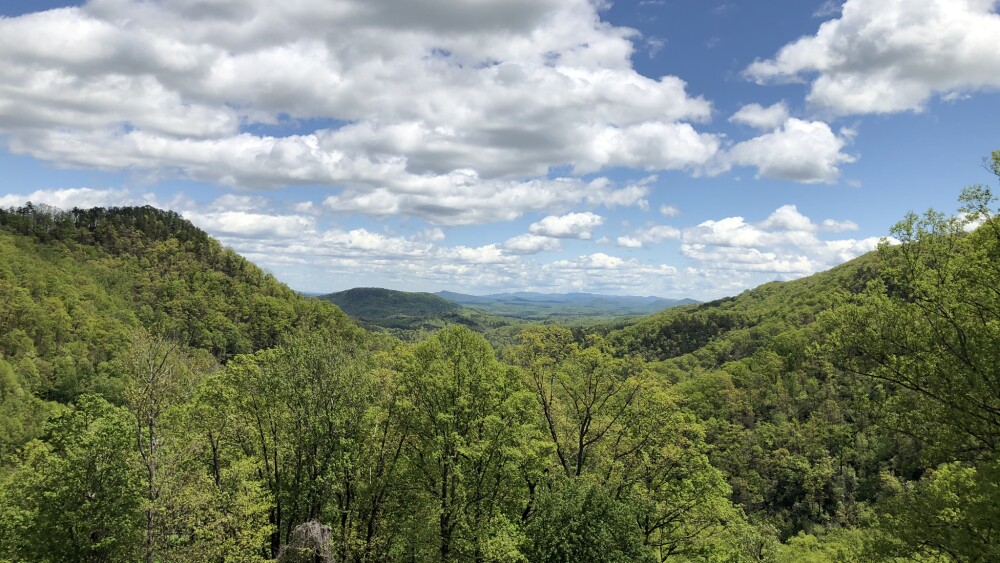By Danny Bernstein, a hiker, hike leader for several local organizations, and an outdoor writer. This is a contributor-submitted Voices piece. Want to join the conversation? We invite you to write for us. Learn how to share your voice here.
This past weekend, Great Smoky Mountains National Park partially opened. I was at the Mingus Creek trailhead at 9 a.m. with a small group of Carolina Mountain Club (CMC) hikers that we’ve named the Covid group. We drive separately, stay six feet apart on the trail, and don’t dip into each other’s trail mix bag the way we used to.
We chose this trail because it was the closest to the North Carolina entrance to the park. Everything I read said that there were going to be huge crowds. At 9 a.m., we were the only cars; when we returned at 4 p.m., there were fewer than ten other cars. On this steep trail – 11.6 miles and 3,000 feet ascent – we only saw five other hikers.
A few weeks ago, my whole world seems to be closing. Stay Home, the North Carolina order says, though outdoor activity was permitted. Staying six feet apart is easy on the trail. But how could we have outdoor activities if almost every piece of public land in Western North Carolina was closed?
On March 17, CMC cancelled all its hikes. This was right after the Appalachian Trail Conservancy made a request to the Department of the Interior to officially close the trail. The A.T. is still officially closed.
Visitor centers and bathrooms on public lands were the first facilities to close to keep their employees from interacting with the public. Fair enough. But people left more trash, toilet paper and poop on the trail. This started the rash of park and forest closures.
Great Smoky Mountains National Park closed March 24. Visitors from across the country had flocked to the area for spring break, wildflowers, and warm weather conditions. Visitors were not paying attention, littering, and worse. The easiest decision was to close. DuPont Forest closed March 24 as well. The whole forest is still enclosed in orange plastic fencing.
Asheville City Parks and Buncombe County Parks closed. Then Cherokee, Nantahala and Pisgah National Forests shut down trailheads to the A.T. While I was at the NC Arboretum on March 30, the word went out that they were closing at the end of the day. At the time, the trails at the Arboretum were almost empty. Again it seemed easier to close the site than to patrol, cajole, and move visitors along.
Many trails and parking areas in the three Pisgah National Forest districts closed on April 13. The Blue Ridge Parkway followed suit a day later, except for the Asheville corridor from French Broad Overlook to Craven Gap.
CMC hikers responded by finding legal places to hike that were still open. For me, it meant doing the same section of the Mountains-to-Sea Trail (MST) over and over again. Ironically, I have paid more attention to flowers than I have in the past. I’ve followed the progression of flowers from the first blood root in March to lady slippers that have just bloomed.
Other hikers drive farther to find secret spots, but there are no secret trails – all public trails are documented somewhere. I receive emails and Facebook comments regularly from occasional hikers who think I have inside knowledge, but I don’t; I just pay more attention to press releases and news articles than most hikers.
Now the Blue Ridge Parkway is also reopening slowly. Governor Cooper gave the OK to reopen the state parks on May 9. But DuPont State Recreational Forest did not reopen on the same day. This is where we see the difference between a park and a forest. Forest management officials are working on how to keep crowds from gathering in front of the iconic waterfalls. Parks and forests in Western North Carolina, on the other hand, don’t have the ability to limit the number of people coming onto their land.
Ultimately it’s up to us, the visitors, to police ourselves, move along, not crowd in front of views and waterfalls – and take our trash home with us. Have a nice hike!
Read more from Danny on her blog, Hiker to Hiker, and follow her on Facebook here.













